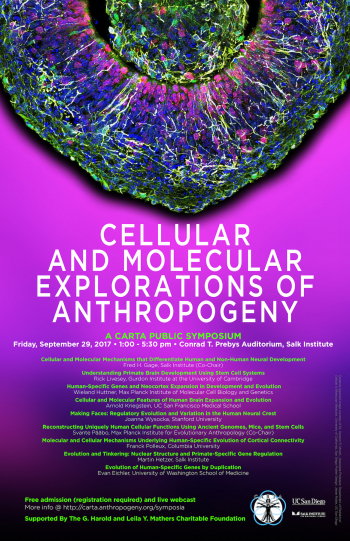Cellular and Molecular Explorations of Anthropogeny
Fred Gage, Salk Institute for Biological Studies
The complete genome sequences of our closest existing and extinct relatives are now readily available. This has not only made possible the identification of positions in the genome where we are similar to chimpanzees and other apes but also reveals where and how all present-day humans, no matter where they live on the planet, are identical to each other but different from Neandertals. Since the genetic differences between these species are those that set modern humans apart from all other organisms on the planet, the identification of these unique positions constitutes an essentially complete “genetic recipe” for being a modern human. A major challenge for the next decade is to identify which of these genetic changes had important consequences, in particular with respect to the cognitive and social abilities that have made the development of rapidly changing technology, large societies, art, and perhaps modern language possible. Understanding the meaning of these differences is a crucial undertaking to fully explain the human condition and to address the diseases and other conditions that affect traits that are unique to humans. The development of the process of generating induced pluripotent stem cells from somatic cells, which can then be differentiated into any cell or tissue type, allows investigators to establish cellular and organ-specific systems to identify functionally important genetic differences occurring through primate evolution. The further establishment of specific gene-editing tools increases the precision through with these studies can reveal important changes. This symposium will be the first of its kind to explore the progress being made in this new area of Cellular and Molecular Anthropogeny.
Media for each talk can be played by clicking on icons in the table below, or by clicking on the individual talk titles below and then the attachment file at the bottom of the page.
| Speakers | Media | Session |
|---|---|---|
 Ajit Varki  Fred Gage |
|
Welcome & Introductory Remarks |
 Fred Gage |
|
Cellular and Molecular Mechanisms that Differentiate Human and Non-Human Neural Development Understanding the evolutionary mechanisms underlying expansion and reorganization of the human brain is essential to comprehend the emergence of the cognitive abilities typical of our species. Comparative analyses of neuronal phenotypes in closely related species (Homo sapiens; human, Pan troglodytes; chimpanzees and Pan paniscus; bonobos) can shed light onto neuronal changes occurring during evolution, the timing of their appearance and the role of evolutionary mechanisms favoring a particular... read more |
 Rick Livesey |
|
Understanding Primate Brain Development Using Stem Cell Systems Variations in cerebral cortex size and complexity are thought to contribute to differences in cognitive ability between humans and other animals. We are using primate stem cell systems to understand the cellular and molecular mechanisms underlying species differences in cerebral cortex development. Directed differentiation to cerebral cortex of human and non-human primates pluripotent stem cells (PSCs) in adherent two-dimensional (2D) and organoid three-dimensional (3D) culture systems enables... read more |
 Wieland Huttner |
|
Human-Specific Genes and Neocortex Expansion in Development and Evolution The expansion of the human neocortex, which constitutes a basis for our cognitive abilities, is due to an increased abundance and proliferative capacity of neural stem and progenitor cells (NPCs) during fetal cortical development. Specifically, NPCs in a secondary germinal zone called the subventricular zone, referred to as basal progenitors (BPs), are thought to be key for neocortex expansion. Here, a particularly important role has been attributed to one specific BP type called basal (or... read more |
 Arnold Kriegstein |
|
Cellular and Molecular Features of Human Brain Expansion and Evolution The developing human brain contains a huge number of cells whose identities have not yet been fully explored but whose specific molecular and functional features lead to the development of human specific abilities. We are using single cell approaches to establish an integrative definition of cell types in the developing human neocortex. Our single cell genomics analysis has revealed the molecular identity of a key human progenitor cell type, termed an outer radial glia cell (oRG). The... read more |
 Joanna Wysocka |
|
Making Faces: Regulatory Evolution and Variation in the Human Neural Crest From Galapagos finches to anteaters, the remarkable diversity of craniofacial structures within the vertebrate species is a testament to the plasticity of development and resourcefulness of evolution. While craniofacial development requires interactions between multiple embryonic cell types, Cranial Neural Crest Cells (CNCCs) play a major role in establishing the central plan of facial morphology as well as determining its species-specific variation. I will discuss an approach we termed ‘... read more |
 Ajit Varki |
|
Multiple Genomic Events Altering Hominin Sialic Acid Biology Predated the Common Ancestor of Humans and Neanderthals Multiple Genomic Events Altering Hominin Sialic Acid Biology Predated the Common Ancestor of Humans and Neanderthals Naazneen Khan1, Stevan Springer1, Marc de Manuel Montero2, Stephane Peyrégne3, Kay Prüfer3, Tomas Marques-Bonet2, Pascal Gagneux1 and Ajit Varki1 1Center for Academic Research and Training in Anthropogeny (CARTA), Glycobiology Research and Training Center (GRTC), Departments of Medicine, Pathology, Cellular & Molecular Medicine and Anthropology, UC San Diego, La Jolla CA,... read more |
 Franck Polleux |
|
Molecular and Cellular Mechanisms Underlying Human-Specific Evolution of Cortical Connectivity Two prominent hallmarks of the human brain are the prolonged maturation time of neuronal circuits and a significant increase in cortical neuron connectivity. These features have been hypothesized to underlie the emergence of higher cognitive functions in modern humans. However, little is known about the molecular changes that have led to the emergence of human-specific traits of cortical development and function. Our attention has recently focused on gene duplications that are unique to the... read more |
 Evan Eichler |
|
The Evolution of Human-Specific Genes by Duplication Huxley and Darwin were among the first to appreciate the close evolutionary relationship of humans and other African great apes but also to ponder what genetic changes might make us human. Initial comparisons of human and chimpanzee genes, however, showed little difference (>99% identical) despite the numerous adaptations that must have occurred on the human lineage. Recent studies of more complex regions of our genome have revealed hotspots of rapid and dramatic evolutionary change.... read more |
 Fred Gage  All Speakers |
|
Wrap-up, Question and Answer Session, Closing Remarks |
| Attachment | Size |
|---|---|
| 1.66 MB | |
| 1.44 MB | |
| 1.11 MB | |
| 8.21 MB | |
| 415.19 KB |
If you enjoy this event, please consider supporting CARTA's quest to explore and explain the human phenomenon.


